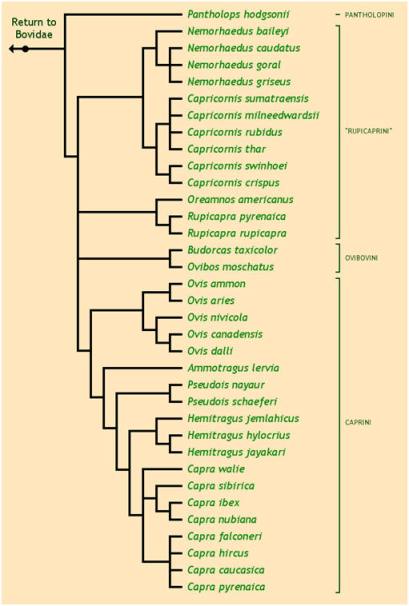Ovis aries: More about Mary's Little Lamb
Sheep through the Ages

The different
species found within the genus Ovis have different
numbers of chromosomes. Phylogenists believe that those
with a higher chromosome count diverged earliest within the
sheep lineage. Ovis vignei
(Urial sheep) have a diploid count of 58, and Ovis ammon
(Argali sheep) have a diploid count of 56. Even earlier forms of
Ovis could have had a 60 diploid count. The majority of
Ovis
have diploid number 54, including Ovis aries, Ovis musimon,
Ovis orientalis, Ovis dalli, and
Ovis canadensis. Ovis nivicola bring up the
rear with a diploid count of 52.
More specifically, Ovis aries is believed to
have branched off of Ovis musimon, but there is no
fossil evidence to support this theory. My phylogenetic tree
places the sheep in order of their chromosome count. The
furthest up within the Ovis genus represents the oldest
species and the lowest represents the youngest species. However,
it is unlikely that each species gave rise to the species below
it in this linear fashion. There was probably a division of two
or three groups of sheep who separately evolved into the various
species we see today.
Although this phylogenetic tree doesn't contain all of the
Ovis species, it better depicts how the sheep may have
diverged into two lineages. Ovis ammon
and Ovis aries make up the first division. Ovis
ammon
was probably the ancestor of Ovis musimon who
eventually gave rise to Ovis aries, the domestic sheep
that we see today.
Developing a phylogenetic tree is no easy task. There are
multiple ways in which different phylogenists can group
organisms. While one phylogenist may use a method like
morphology, another phylogenist may use shared derived
characteristics. A third phylogenist may use a combination of
the two techniques. The possibilities are limitless, and no one
tree can be completely verified.
Previous
Click here
to learn about how sheep and goats are different
Baaack Home
